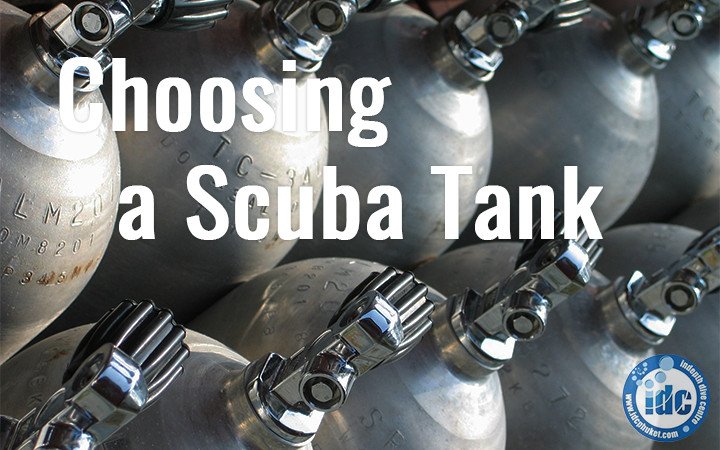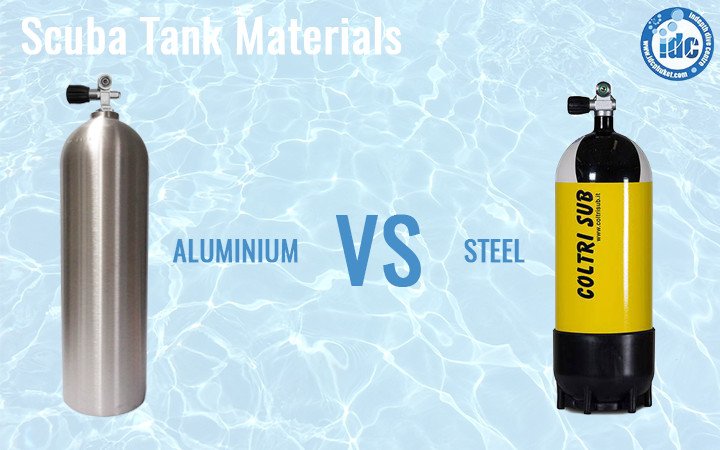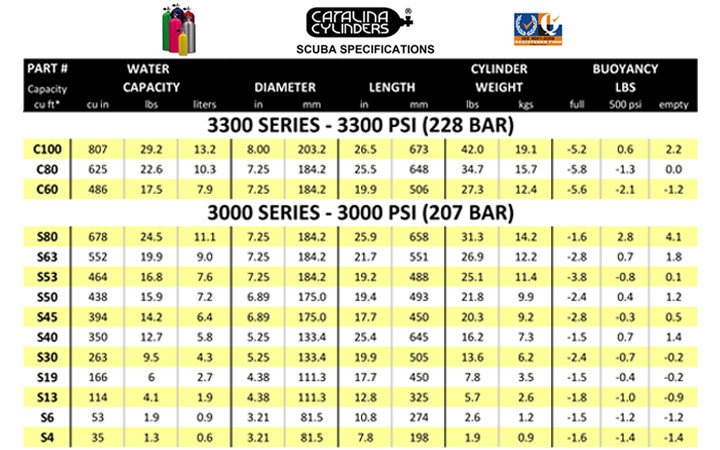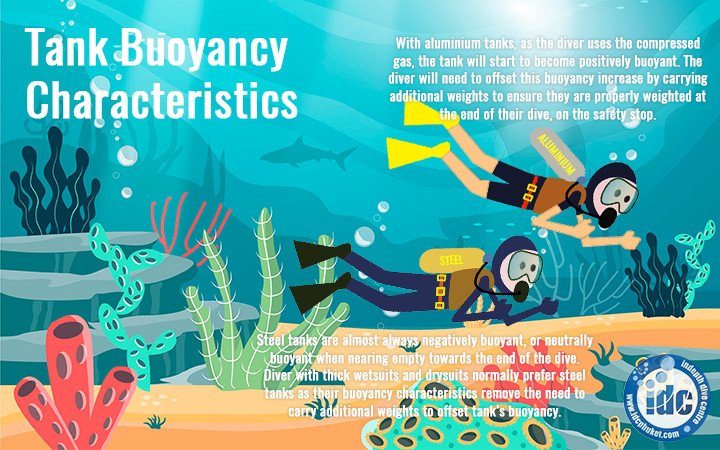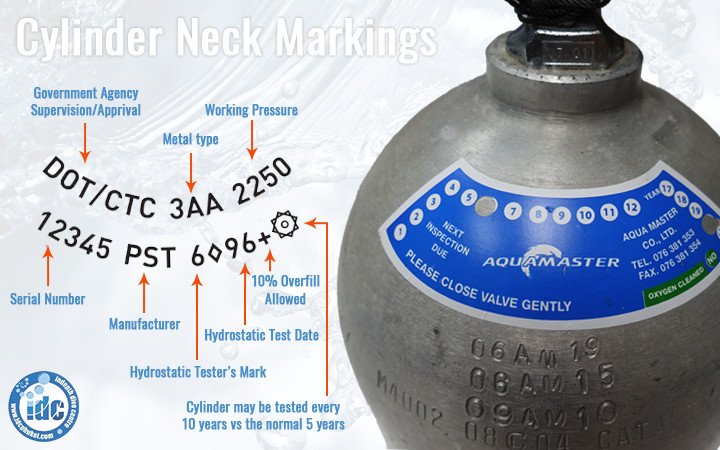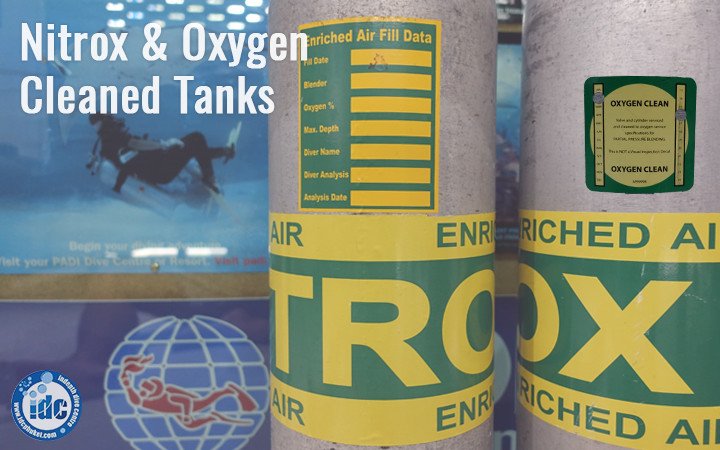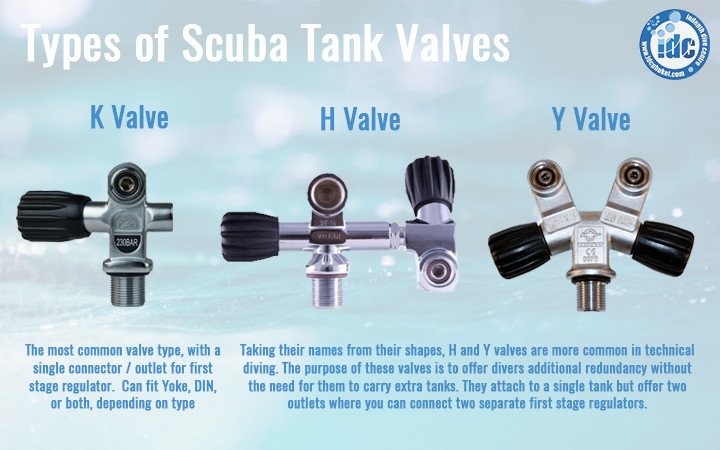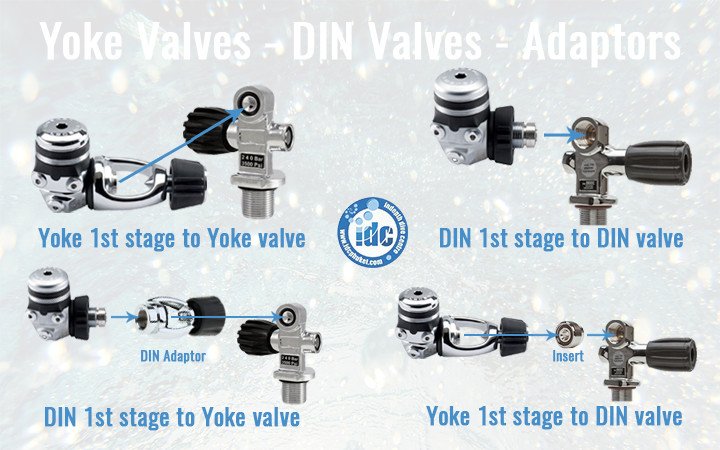Choosing a Scuba Tank – All About Compressed Gas Cylinders and Valves
Choosing a Scuba Tank – All you need to know. A compressed gas cylinder with a valve, more commonly known as a scuba tank, is considered standard scuba equipment. You cannot scuba dive without them. Your scuba tank holds the compressed gas, or air, which you will breathe during the dive and the valve is what your scuba regulator from which you breathe, attaches to. To the uninitiated a scuba tank may seem pretty straight forward, after all, they do all kind of look the same.
However, you might want to learn that different tanks are made from different materials, have different sizes and different buoyancy characteristics, different working pressures and contain different amounts and types of gases. The valves themselves are varied and may require the use of different or specialised equipment. In this blog, we’ll look at the different types of tanks, valves as well as explain what the markings and stickers on your cylinder mean and have a look at the maintenance of scuba tanks. This is by no means exhaustive. If you have a question about a particular type of tank or piece of equipment you are using, contact us here and we will be happy to help.
Materials – Choosing a Scuba Tank
Most scuba tanks are available in one of two materials; either steel or aluminium alloy. Other composites and materials are possible however this article will focus on steel and aluminium tanks which are the most commonly used and widely available in recreational diving.
Different regions favour different tanks for various reasons. Colder regions prefer steel tanks because of their buoyancy characteristics which can offset the buoyancy of thick wetsuits and drysuits. Here in Phuket, we almost exclusively use aluminium cylinders made by the manufacturers Catalina, which is a US-based company, and Luxfer, a company whose headquarters is in the UK. For both Catalina and Luxfer tanks, the manufacturer’s name is stamped into the tank allowing the user to easily identify them.
Material strength and weight
When choosing a scuba tank consider that steel, as a material, is much stronger than aluminium. This means it is generally more durable and resistant to external damage. Consequently, and because aluminium is a softer metal, aluminium tanks often need to have thicker walls in order to compensate for the reduced strength. This can render some aluminium tanks heavier to handle on land, although in the water, aluminium tanks can be buoyant. Due to their strength, steel tanks are also generally capable of holding higher gas pressures than aluminium tanks.
Maintenance based on material
Although the maintenance for both tank types is similar, steel tanks often need more care as they have thinner walls rendering them more susceptible to internal corrosion; particularly in tropical climates. Corrosion can weaken the cylinder, thinning the walls and causing pitting. Additional and more expensive maintenance such as sandblasting may be required for steel tanks. By comparison, if an aluminium cylinder has internal corrosion it can be removed with a water jet which is usually a cheaper and more accessible option in remote locations. In tropical climates, where you often have local staff who are not trained divers handling the tanks, aluminium tanks are preferred because they are resistant to corrosion and don’t require the same level of care which steel tanks do.
Working Pressures, Size and Capacity
Working Pressures
When choosing a scuba tank consider that different tanks are capable of being filled to different working pressures. If you try to overfill a tank, a small copper disk in the tank valve, known as the burst disk will rupture to prevent the tank from bursting. Your ability to fill a tank to a particular pressure is not only dependant on the working pressure of the tank itself, but the ability of the compressor to fill the tank to a higher pressure.
There are three common categories of tanks with regards to pressure:
- Low-pressure tanks which have a working pressure of 2400-2540psi, or 165 bar;
- Standard tanks which have a working pressure of 3000psi or 207 bar; or
- High-pressure tanks which have a working pressure of 3300-3500psi or 228 bar.
Almost all aluminium tanks are rated to a working pressure of 3000psi, or 207 bar. Commonly, steel cylinders can hold higher pressures due to the strength of steel as a material over aluminium.
If you are a diver who consumes more gas, rather than trying to increase the pressure in your tank, you can simply change to a larger sized tank with a different gas capacity but which is still pressurised to a standard level. This is an easier and often more accessible alternative, particularly in tropical climates where only aluminium tanks are available.
Size and Capacity – Choosing a Scuba Tank
Volume
The volume of scuba cylinders is commonly measured in either cubic inches or litres of water. Depending on the manufacturer, the capacity in cubic feet may even be stamped into the tank. For example, on Phuket’s diving boats we commonly use Catalina aluminium cylinders which have “S80” stamped into them. Just by looking at the tank, you could assume this tank had a capacity of 80 cubic feet. In fact, this number is actually rounded up and the manufacturer’s specifications more accurately state this tank has a capacity of 77.4 cubic feet.
Capacity
To determine how much gas is in your tank, you need to know what the capacity of the tank is in litres. Fortunately, this is published in the manufacturer’s tank specifications (see also the image above). To use the example of the S80 tank above, the Catalina tank specifications state an S80 tank has a litre capacity of 11.1L. Once you have this number, you can then multiply the litre capacity of the tank by the pressure it is filled to and determine how much gas you have available for the dive. Although this tank is rated to a working pressure of 207 bar, in Phuket the dive boat compressors fill tanks to 200 bar so for the purposes of this example, we will use 200 bar.
To calculate the gas in an 11.1L tank filled to 200 bar, you simply multiply the two numbers as follows:
11.1L x 200 bar = 2,220L of gas.
2,220L of gas sounds like a lot but you need to know how much gas are you going to breathe per minute at atmospheric pressure in order to determine how much gas you are going to consume at depth. You can then determine the cylinder capacity you need in order to safely complete the dive you plan to make. To plan your dive this way, you need to know what your Surface Air Consumption Rate is.
Without knowing this, it is common for many new divers to just look at their submersible pressure gauge without really understanding the physics behind gas consumption, or to simply compare their pressure gauge to their buddy’s to see whether they think they need a bigger tank.
SAC Rate
Fortunately, there is a more precise and accurate method of determining your individual gas consumption and gas requirements. This is called SAC Rate and you will learn more about it on your Deep Diver Speciality Course. To book your course and to learn more about effective gas management and to improve your dive planning and safety, click here.
Buoyancy Characteristics – Choosing a Scuba Tank
The buoyancy characteristics of your tank will depend on its material as well as its size. Steel tanks are almost always negatively buoyant. At best, they may become neutrally buoyant when nearing empty towards the end of the dive. Some divers, particularly those wearing thick wetsuits and drysuits, prefer steel tanks. This is because their buoyancy characteristics remove the need to carry additional weights to offset the buoyancy of the tank.
Aluminium tanks on the other hand change their buoyancy throughout the dive and in response to the diver’s gas consumption. If we stick with the example of a Catalina S80 tank, at the start of the dive when the tank is full, it will be -1.6lbs, or –0.7kg negatively buoyant, meaning at the start of the dive, the diver will have to compensate for this by adding air to the buoyancy control device. As the diver uses the gas inside the tank, the tank will start to become positively buoyant. At the end of the dive when the tank is down to 500psi or approximately 50 bar, it will be 2.8lbs or 1.2kgs positively buoyant.
This means the diver will need to offset this buoyancy increase by carrying additional weights to ensure they are properly weighted at the end of their dive, on the safety stop. For this reason, we conduct buoyancy checks at the end of the dive when the tank is down to 50 bar of pressure.
If you would like to learn more about the buoyancy characteristics of your equipment, including your tank and work with an instructor to fine-tune your weighting and buoyancy control, book your Peak Performance Buoyancy speciality course here.
Maintenance
Visual inspection every year
All scuba cylinders need to be visually inspected once a year and hydrostatically tested every 5 years. In many places, this is mandated by law. If the tank is used frequently, it may require maintenance more regularly. The purpose of a visual inspection is to check the tank for any corrosion, cracking, dents or bumps. Such flaws may compromise the safety of the tank when under pressure. During the visual inspection, the valve is removed from the tank and inspected; including the burst disk and O-ring, as is the interior and exterior of the tank. Once the tank has passed its inspection, a sticker will be added to the neck of the tank. This will inform users about the date of the tank’s last inspection and when it is due again.
Hydrostatic testing every 5 years
In addition to visual inspections, once every five years, a tank needs to undergo hydrostatic testing. The purpose of the hydrostatic test is to identify any flaws with the tank which may compromise the diver’s safety. The hydrostatic test goes further than the visual inspection by physically testing the strength of the tank with pressurised water. During this process, the technician is looking for leaks. The tank is filled with water and submerged in a sealed chamber, before being pressurised above its working pressure. The water displaced is then measured. The expansion of the tank is then analysed by the technician who will determine whether the tank is safe to keep using. If so, the hydrostatic test date and the tester’s identification will be stamped into the neck of the tank.
Markings and stickers
All scuba cylinders have marking stamped into the neck which provides basic information about the tank to the diver. On the Open Water Course, you learn to visually inspect your tank to ensure it is within its service dates and safe to use. Markings on the tank include the government certification and approval markings, what type of metal the tank is made from, as well as its working pressure. The tank’s serial number is printed, as is the manufacturer’s name. You will also find the hydrostatic tester’s mark and date of the last hydrostatic test on the tank.
In additional to marks physically stamped into the tank, the tank will also have stickers on it. The most common sticker is the annual visual inspection record which will show the due date for the next annual inspection. As a general rule, you should check your tanks before each dive to ensure they are within their required testing dates. If a tank does not appear to be within its testing dates, do not use it.
Nitrox and Oxygen Cleaned Cylinders – Choosing a Scuba Tank
While most tanks are filled with air, some are designed to hold different gas mixtures and will be marked accordingly. Usually with bright and large stickers.
Nitrox tanks hold gas mixtures which contain anywhere from 21-40% oxygen and can be used with regular scuba equipment. Nitrox is an increasingly popular option for recreational divers as the decreased nitrogen content allows for longer no-decompression limits.
To prevent untrained divers from inadvertently taking one, nitrox tanks commonly have a large green and yellow sticker around the tank’s body, as well as a smaller green and yellow sticker around the neck t.
Other tanks are designed to carry gas mixtures with an oxygen content above 40%. These tanks cannot be used with regular scuba equipment and can only be used with oxygen cleaned first stage regulators. These tanks are commonly marked with stickers which are often black and white. It is important you only use these cylinders after taking the proper training and never to refill them with air.
If you would like to learn about diving on different gas mixtures, you can take your Enriched Air Nitrox course which can be booked here.
Types of Valves – K, H and Y Valves
K Valves
All scuba tanks need to have a valve, this is where we attach our first stage regulators to breathe from. The most common valve, and which most divers are familiar with is referred to as a K valve. K valves can have Yoke or DIN outlets (see further below). The valve sits on the tank’s top and will have a rotating knob to open or close the tank. Although valves vary, they all have a rubber O-ring creating a seal between the valve and the first stage regulator when attached. Depending on the valve type, the O-ring may be located on the tank valve itself or on the first stage.
Most tank valves are also fitted with a copper burst disk. This is a safety feature as this small disk will burst if the tank exceeds its pressure capacity. This will allow the gas to escape and stop the tank itself from rupturing which can cause serious injury.
H Valves and Y Valves
H valves and Y valves get their names from their shapes which resemble the letters H and Y. The purpose of these valves is to offer divers additional redundancy without the need for them to carry extra tanks. These valves attach to a single tank but offer two outlets where you can connect two separate first stage regulators. These valves are more common in technical diving, however, provide little benefit to the diver if a gas leak occurs from the burst disk, or in the event of a gas leak between the cylinder’s neck and the valve itself. For this reason, most technical divers carry separate tanks with separate first stage regulators attached.
With any piece of scuba equipment, whether you are looking to rent or buy, we are happy to help you. If you have a question or would like to do some dives with us, please contact us by clicking here.
DIN and Yoke, and Adaptors
On your Open Water Course, you learn about a Yoke regulator/valve versus a DIN regulator/valve and what is immediately obvious to even the untrained eye is that both look different and attach to the tank in different ways.
Knowing whether you need a Yoke or a DIN valve is very important when choosing a scuba tank.
Yoke / INT Valves
The most common type is the Yoke valve which is also referred to as an international fitting (INT). On a Yoke valve, the O-ring inserts into the tank and the regulator first stage fits over the top of it to create a seal. A yoke fitting is a clamp style mounting which is placed over the tank and screwed into place.
DIN Valves
The other variety of valve is DIN which stands for Deutsche Industrie Norm, which is the developer based in Germany. A DIN tank is characterised by a hollowed-out, threaded valve in which the regulator physically screws in. On a DIN first stage regulator, the O-ring is found on the first stage and not on the tank valve.
DIN valves are more popular in technical diving as they are capable of handling pressures up to 300 bar, whereas a Yoke attachment can only function up to 200 bar. DIN valves are preferred for overhead environments, such as inside caves because they are more resistant to impact. A Yoke fitting may be bumped or broken in these environments, causing a loss of gas from the tank.
Compatibility
Many DIN tank valves have a Yoke attachment which you can simply unscrew using an Allen key. This makes them the most versatile as they fit both types of first stage regulator. Not all Yoke tanks can be converted to accommodate a DIN regulator though. In this case, you’ll need to apply a DIN adaptor to the first stage regulator to convert it to Yoke.
More posts about diving equipment:
- Choosing Dive Equipment
- Choosing a Scuba Diving Mask
- All about snorkels
- Choosing the right fins
- Buoyancy Control Devices (BCDs)
- How to choose a Scuba Regulator
- Breathing Gas Monitoring Devices
- Depth Monitoring Devices
- Scuba Diving Weights & Quick Release Weight Systems
- Choosing a wetsuit for Scuba Diving
- Audible Signaling Devices for Scuba Diving
- Choosing a Scuba Diving Compass
Photo Credits:
Background of image # 4 Designed by pikisuperstar / Freepik



